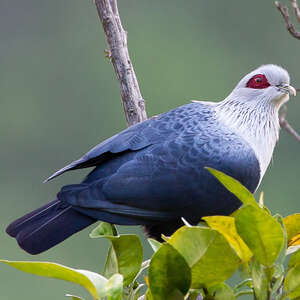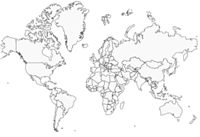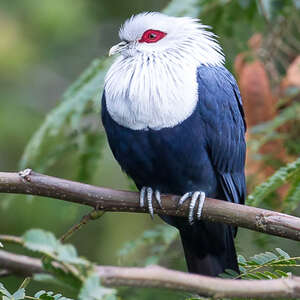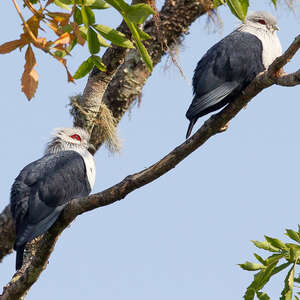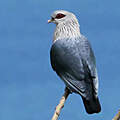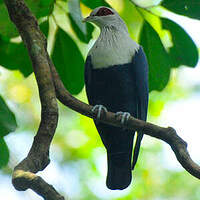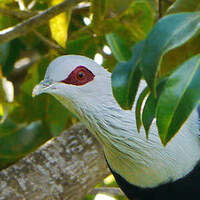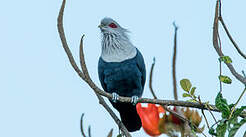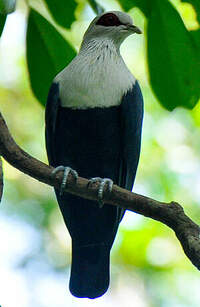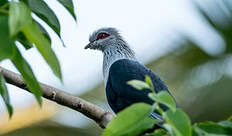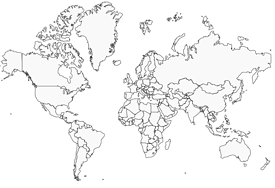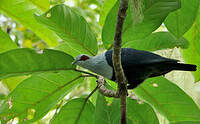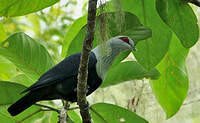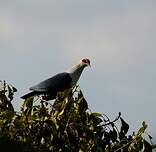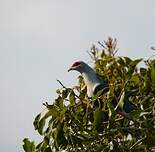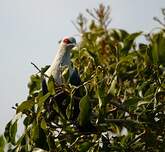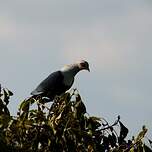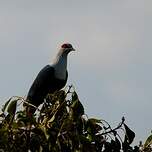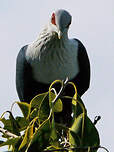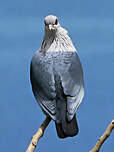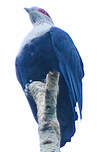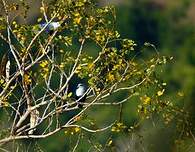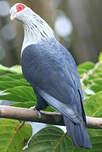Comoros Blue Pigeon
Alectroenas sganzini - Founingo des Comores
Description identification
The Comoros Blue Pigeon is a large pigeon whose body is entirely blue-petrol. It cannot be mistaken for any other pigeon from the Indian Ocean region. The head and neck are white, as well as the chest whose feathers look like spearheads. These are the only two white parts contrasting with the darker body. A naked and red skin surrounds the almond-shaped eye which can be seen from several dozen metres away. The iris is yellow, the beak is olive green with a slightly lighter tip. The legs are light grey.
There does not seem to be any sexual dimorphism, although the female seems bigger than the males with a less brilliant plumage.
Subspecific information 2 subspecies
- Alectroenas sganzini sganzini (Comoros)
- Alectroenas sganzini minor (Aldabra)
Foreign names
- Founingo des Comores,
- Paloma azul de las Comoras,
- pombo-azul-das-comores,
- Komorenfruchttaube,
- comore-szigeteki gyümölcsgalamb,
- Comorese Blauwe Duif,
- Piccione blu delle Comore,
- komorblåduva,
- Brilleblådue,
- pestroš kapucňový,
- holub modrobřichý,
- Comorerblådue,
- komoriensinikyyhky,
- colom blau de les illes Comores,
- koralczyk srebrnogłowy,
- Коморский синий голубь,
- コモロルリバト,
- 科摩罗蓝鸠,
- 科摩羅藍鳩,
Habitat
The Comoros Blue Pigeon is a forest bird. It prefers evergreen forests although it can travel to look for its food. Wet forests suit it better but it can also be found in secondary forests as long as there are tall trees for it to perch in. It is less common in mangroves, at least in Mayotte. On Aldabra, it frequents every type of wooded habitat.
Behaviour character trait
Dietfeeding habits
Reproduction nesting
Geographic range
The Comoros Blue Pigeon is endemic to the four islands of the Comoros and on Aldabra where it is locally common depending on the availability of food sources such as fruits. On Grand Comoros it is present from 400 to 1,800 meters in elevation. On Mohéli it is present from 200 meters up to the first wooded ridge. On Anjouan it is present from 500 meters and up. On Mayotte it is present from sea level up to the higher mountains. To date, there are no known inter-island movements of the Comoros Blue Pigeon.
Threats - protection
Sources of information
- IOC World Bird List (v13.2), Gill, F and D Donsker (Eds). 2023.
- Les Oiseaux de Mayotte, Clément Michel, Grissac Philippe, Rolland Robin
- The Birds of Africa Vol VIII : The Malagasy Region, Safford R. et Hawkins F.
Other sources of interest
 Specification sheet created on
25/07/2023 by Nathalie Santa Maria
Specification sheet created on
25/07/2023 by Nathalie Santa MariaTranslation by AI Oiseaux.net
published: 24-08-2015 - Updated: 30-08-2015
© 1996-2023 Oiseaux.net
- Accipitriformes
- Aegotheliformes
- Anseriformes
- Apodiformes
- Apterygiformes
- Bucerotiformes
- Caprimulgiformes
- Cariamiformes
- Casuariiformes
- Charadriiformes
- Ciconiiformes
- Coliiformes
- Columbiformes
- Coraciiformes
- Cuculiformes
- Eurypygiformes
- Falconiformes
- Galliformes
- Gaviiformes
- Gruiformes
- Leptosomiformes
- Mesitornithiformes
- Musophagiformes
- Nyctibiiformes
- Opisthocomiformes
- Otidiformes
- Passeriformes
- Pelecaniformes
- Phaethontiformes
- Phoenicopteriformes
- Piciformes
- Podargiformes
- Podicipediformes
- Procellariiformes
- Psittaciformes
- Pterocliformes
- Rheiformes
- Sphenisciformes
- Steatornithiformes
- Strigiformes
- Struthioniformes
- Suliformes
- Tinamiformes
- Trogoniformes

